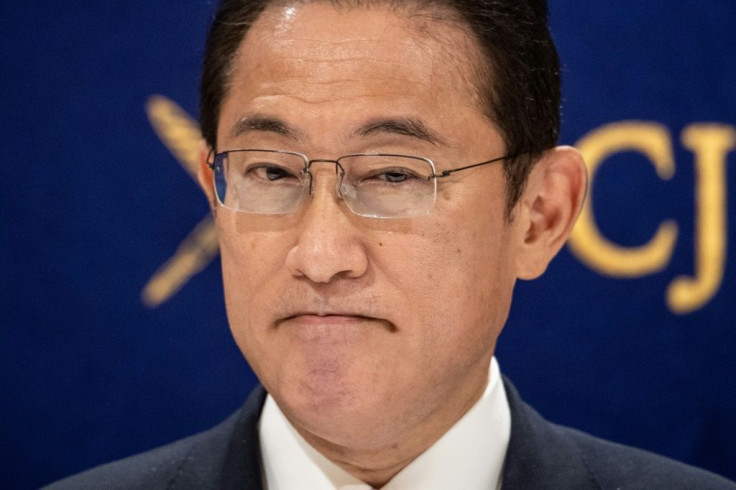5.9 Magnitude Earthquake Strikes Japan; Strongest Jolt Felt In Tokyo Since 2011
KEY POINTS
- Many people were temporarily trapped in elevators following the quake
- The earthquake damaged underground water pipes, halted trains and subways
- No tsunami warning was issued and no abnormalities were detected in nuclear facilities
A 5.9 magnitude earthquake jolted Japan’s northwestern Chiba Prefecture, which lies east of the capital Tokyo, on Thursday night. At least 32 people were reported injured in one of the strongest temblors to strike Tokyo since the devastating 9.0 earthquake and tsunami disaster in 2011 that killed thousands.
According to the Japan Meteorological Agency, there was no tsunami risk but the quake was felt strongly across Tokyo. The temblor damaged underground water pipes, halted trains and subways, Associated Press reported.
Japan’s Cabinet Office of Disaster Prevention stated the earthquake occurred around 22.41 local time and was focused in the Northwestern Chiba prefecture. The Japan Meteorological Agency initially registered the earthquake's magnitude as 6.1 with an initial depth of 80 kilometers (50 miles) but later updated it to 5.9 magnitude with a depth of 62 kilometers (38.5 miles), CNN reported citing the United States Geological Survey.
Nuclear facilities did not detect any abnormalities following the earthquake, Japan's Chief Cabinet Secretary Hirokazu Matsuno was quoted as saying by the outlet.
[Earthquake Information] 22:41 JST on 07 Oct 2021, Seismic intensity 5+ at Southern Saitama Prefecture. Epicenter:Northwestern Chiba Prefecture , depth 80km, estimated magnitude 6.1.
— 内閣府防災 (@CAO_BOUSAI) October 7, 2021
According to Japan’s Chief Cabinet Secretary, multiple people reported sustaining minor injuries. The Fire and Disaster Management Agency said Friday that at least 32 people were injured, including three with serious injuries. Following the quake, two cases of fire were reported.
View of a store in Tokyo. Things rattling due to 6.1 magnitude earthquake. Prayers for #Tokyo #earthquake #Japan pic.twitter.com/w7fieK68Do
— Adnan Faheem, GPHR, SPHRi, SHRM-SCP (@AF2311) October 7, 2021
No major blackouts were reported across the Tokyo and Chiba area but multiple water leaks occurred due to broken pipes. Several elevators reportedly stopped working, temporarily trapping people inside.
Following the quake, one Twitter user wrote to the Disaster Prevention office, “Many elevators were trapped in the previous earthquake, so please check all elevators as soon as possible.”
前の地震でエレベータに閉じ込められが多かったので大至急、全エレベータの確認をお願いします❗
— 高安 セイゴ (@75b8553daa1144e) October 7, 2021
Some railway lines were suspended following the earthquake. Several people got stranded at railway stations in Tokyo, Kanagawa and Chiba. Some took shelter at facilities set up by local municipalities.
M6.2 #earthquake (#地震) strikes 52 km E of #Tokyo (#Japan) 11 min ago. Effects reported by eyewitnesses: pic.twitter.com/aY2nci6S2q
— EMSC (@LastQuake) October 7, 2021
On Friday morning, trains operated with major delays and entry restrictions to prevent overcrowding. Traffic disruptions were also reported, according to Associated Press.
Japan’s new Prime Minister Fumio Kishida, who took office Monday, set up a crisis management task force to oversee the government’s response to the earthquake.
Taking to Twitter, he urged people to “check the latest information and take action to protect your lives.” He told reporters it was the strongest shaking in Tokyo since March 11, 2011, when a 9.0 magnitude earthquake shook the northeast of Japan and killed almost 20,000 people.
— Boktear Md Shamim (@SBoktear) October 7, 2021
"We have a safety alert app on our phones. It started going off moments before the shaking saying 'an earthquake is coming.' The shaking was really strong. Sounded and felt like the house was going to crumble," said CNN correspondent Blake Essig.
Breaking: Magnitude 6.2 earthquake strikes near Tokyo, Japan. pic.twitter.com/z2fEAyE4cR
— PM Breaking News (@PMBreakingNews) October 7, 2021
The meteorological agency warned that more quakes of the same intensity may follow over the next week, reported NHK News.

© Copyright IBTimes 2024. All rights reserved.





















